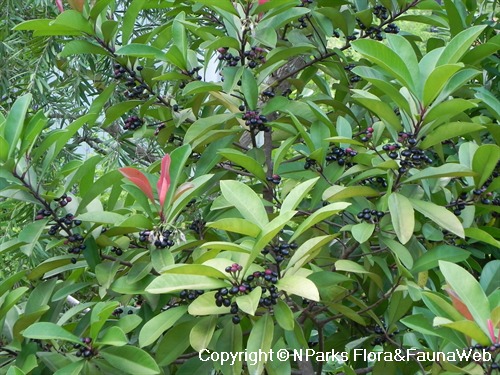
Back
Ardisia elliptica Thunb.
| Family Name: | Primulaceae |
| Synonyms: | Ardisia littoralis Andr. |
| Common Name: | Seashore Ardisia, Mata Pelandok, Mempenai, Rempenai, Shoebutton Ardisia, Mata Pelanduk, Penah, Periah, Buah Letus, Cempenai, Daun Bisa Hati, Mata Ayam, Mata Itek, 东方紫金牛 |
Name
Classifications and Characteristics
| Plant Division | Angiosperms (Flowering Seed Plants) (Dicotyledon) |
|---|---|
| Plant Growth Form | Tree (Small (6m-15m)), Shrub |
| Lifespan (in Singapore) | Perennial |
| Mode of Nutrition | Autotrophic |
| Maximum Height | 8 m |
Biogeography
| Native Distribution | From India, Southeast Asia to New Guinea |
|---|---|
| Native Habitat | Terrestrial (Coastal Forest), Shoreline (Mangrove Forest, Backshore, Sandy Beach) |
| Preferred Climate Zone | Tropical |
| Local Conservation Status | Native to Singapore (Least Concern (LC)) |
Description and Ethnobotany
| Growth Form | It is a shrub or small tree up to 8 m tall. |
|---|---|
| Foliage | Its alternate, stalked leaves have fleshy or leathery leaf blades that are elliptic, and 5-16 by 2.5-7 cm. The new leaves are reddish in colour. |
| Flowers | Its flowers grow in stalked clusters from the leaf angles along the twigs. The flowers have drooping waxy, pink flower buds and are about 15 mm wide. |
| Fruit | Its 10 mm wide fruits are round berries that are flattened at the tip, ripening from reddish-purple to black and contain a single seed. |
| Habitat | It grows along the banks of tidal estuaries, and sandy or muddy shores. |
| Associated Fauna | It is the food plant for the caterpillars of the butterflies Malayan Plum Judy (Abisara saturata), The Dark Malayan Sixline Blue (Nacaduba calauria malayica), and the Bagworm Moth (Chalioides sumatrensis), and other moths. The fruits are dispersed by birds. Flowers attract Pearly-banded Bee (Nomia strigata) and Sunda Blue-banded Digger Bee (Amegilla andrewsi). |
| Cultivation | It can be propagated by seeds. |
| Ethnobotanical Uses | Edible Plant Parts : Edible Leaves Food (Fruit or Vegetable): The young shoots are eaten. Medicinal: Scientific Evidence of Medicinal Properties Based on research on the effects of Seashore Ardisia on animals, it has these medicinal properties: anti-diabetic <1> and antioxidant <2> Traditional Medicinal Uses In Southeast Asia countries like Indonesia, the plant is used in traditional medicine to treat a wide variety of conditions, such as hypertension, diabetes, digestion <3>. It is important to note that some therapeutic effects from traditional medicinal uses of plants are not currently supported or verified by scientific research. |
Landscaping Features
| Landscaping | Its seasonal flushes of colourful young leaves, pink flowers, and reddish-purple fruits that turn black, make it an attractive plant as a hedge or as a gap-filler between roadside trees. It can also be planted in parks and small gardens. |
|---|---|
| Desirable Plant Features | Ornamental Flowers, Ornamental Foliage, Ornamental Fruits |
| Landscape Uses | Coastal, General, Suitable for Roadsides, Parks & Gardens, Small Gardens, Beachfront / Shoreline, Hedge / Screening |
| Thematic Landscaping | Bird & Wildlife Garden |
Fauna, Pollination and Dispersal
| Fauna Pollination Dispersal Associated Fauna | Bird-Attracting, Butterfly Host Plant (Leaves, Associated with: Abisara saturata kausambioides (de Nicéville, 1896), Taxila haquinus haquinus (Fabricius, 1793)), Caterpillar Moth Food Plant, Bee-Attracting |
|---|---|
| Pollination Method(s) | Biotic (Fauna) |
| Seed or Spore Dispersal | Biotic (Fauna) |
Plant Care and Propagation
| Light Preference | Semi-Shade, Full Sun |
|---|---|
| Water Preference | Moderate Water |
| Plant Growth Rate | Moderate |
| Rootzone Tolerance | Moist Soils, Well-Drained Soils, Fertile Loamy Soils, Easy to Grow |
Foliar
| Foliage Retention | Evergreen |
|---|---|
| Mature Foliage Colour(s) | Green |
| Mature Foliage Texture(s) | Leathery |
| Prominent Young Flush Colour(s) | Red |
| Young Flush Texture(s) | Leathery |
| Foliar Type | Simple / Unifoliate |
| Foliar Arrangement Along Stem | Alternate |
| Foliar Attachment to Stem | Petiolate |
| Foliar Shape(s) | Non-Palm Foliage |
| Foliar Venation | Pinnate / Net |
| Foliar Margin | Entire |
| Leaf Area Index (LAI) for Green Plot Ratio | 3.0 (Tree - Intermediate Canopy) |
Floral (Angiosperm)
| Flower & Plant Sexuality | Bisexual Flowers |
| Flower Colour(s) | Pink |
|---|---|
| Flower Grouping | Cluster / Inflorescence |
| Flower Location | Axillary |
| Flower Symmetry | Radial |
Fruit, Seed and Spore
| Mature Fruit Colour(s) | Black, Purple |
|---|---|
| Mature Fruit Texture(s) | Glossy / Shiny |
| Fruit Classification | Simple Fruit |
| Fruit Type |
References
| References | <1> Agustini, K., Rosidah, I., Ngatinem, N., Ningsih, S., Effendi, J., Amin, M. & Suryohastari, B. (2023). Effects of Ardisia elliptica Thunb. on Diabetes Mellitus Type 2 Rat Models. Advances in Health Sciences Research: 719-728. <3> Minarno, E.B., Rubani, A. & Ridho, M.R. (2023). Ethnobotany of Medicinal Wild Plants in the community of Kutorejo Subvillage, buffer area of Alas Purwo National Parks Banyuwangi Regency. Advances in Engineering Research: 110-117. |
|---|
Image Repository
Others
| Master ID | 1434 |
|---|---|
| Species ID | 2727 |
| Flora Disclaimer | The information in this website has been compiled from reliable sources, such as reference works on medicinal plants. It is not a substitute for medical advice or treatment and NParks does not purport to provide any medical advice. Readers should always consult his/her physician before using or consuming a plant for medicinal purposes. |

_lowres.jpg)
_lowres.jpg)
_lowres.jpg)




















